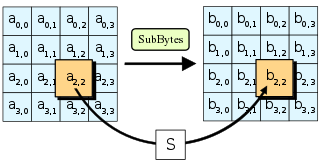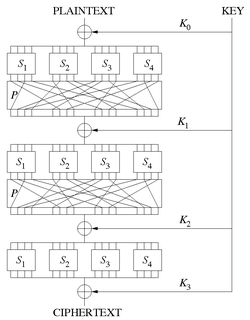 The LOKI97 round function | |
| General | |
|---|---|
| Designers | Lawrie Brown, assisted by Jennifer Seberry and Josef Pieprzyk |
| First published | 1998 |
| Derived from | LOKI91 |
| Cipher detail | |
| Key sizes | 128, 192 or 256 bits |
| Block sizes | 128 bits |
| Structure | Feistel network |
| Rounds | 16 |
| Best public cryptanalysis | |
| Linear cryptanalysis against LOKI97, requiring 256 known plaintexts (Knudsen and Rijmen, 1999) | |
In cryptography, LOKI97 is a block cipher which was a candidate in the Advanced Encryption Standard competition. It is a member of the LOKI family of ciphers, with earlier instances being LOKI89 and LOKI91. LOKI97 was designed by Lawrie Brown, assisted by Jennifer Seberry and Josef Pieprzyk.

Cryptography or cryptology is the practice and study of techniques for secure communication in the presence of third parties called adversaries. More generally, cryptography is about constructing and analyzing protocols that prevent third parties or the public from reading private messages; various aspects in information security such as data confidentiality, data integrity, authentication, and non-repudiation are central to modern cryptography. Modern cryptography exists at the intersection of the disciplines of mathematics, computer science, electrical engineering, communication science, and physics. Applications of cryptography include electronic commerce, chip-based payment cards, digital currencies, computer passwords, and military communications.
In cryptography, a block cipher is a deterministic algorithm operating on fixed-length groups of bits, called a block, with an unvarying transformation that is specified by a symmetric key. Block ciphers operate as important elementary components in the design of many cryptographic protocols, and are widely used to implement encryption of bulk data.
Lawrence Peter "Lawrie" Brown is a cryptographer and computer security researcher, currently a Senior Lecturer with UNSW Canberra at the Australian Defence Force Academy. His notable work includes the design of the block ciphers LOKI and the AES candidate LOKI97. He received his Ph.D. in mathematics from the University of New South Wales in 1991, with a dissertation on the design of LOKI and the cryptanalysis of the Data Encryption Standard. Subsequently, his research changed focus to the Safe Erlang mobile code system, to aspects of trust issues in eCommerce with some of his Ph.D. students, and with the use of Proxy Certificates for Client Authentication.
Contents
Like DES, LOKI97 is a 16-round Feistel cipher, and like other AES candidates, has a 128-bit block size and a choice of a 128-, 192- or 256-bit key length. It uses 16 rounds of a balanced Feistel network to process the input data blocks (see diagram right). The complex round function f incorporates two substitution-permutation layers in each round. The key schedule is also a Feistel structure – an unbalanced one unlike the main network — but using the same F-function.

The Data Encryption Standard is a symmetric-key algorithm for the encryption of electronic data. Although its short key length of 56 bits, criticized from the beginning, makes it too insecure for most current applications, it was highly influential in the advancement of modern cryptography.
In cryptography, a Feistel cipher is a symmetric structure used in the construction of block ciphers, named after the German-born physicist and cryptographer Horst Feistel who did pioneering research while working for IBM (USA); it is also commonly known as a Feistel network. A large proportion of block ciphers use the scheme, including the Data Encryption Standard (DES). The Feistel structure has the advantage that encryption and decryption operations are very similar, even identical in some cases, requiring only a reversal of the key schedule. Therefore, the size of the code or circuitry required to implement such a cipher is nearly halved.

The Advanced Encryption Standard (AES), also known by its original name Rijndael, is a specification for the encryption of electronic data established by the U.S. National Institute of Standards and Technology (NIST) in 2001.

The LOKI97 round function (shown right) uses two columns each with multiple copies of two basic S-boxes. These S-boxes are designed to be highly non-linear and have a good XOR profile. The permutations before and between serve to provide auto-keying and to diffuse the S-box outputs as quickly as possible.
In cryptography, an S-box (substitution-box) is a basic component of symmetric key algorithms which performs substitution. In block ciphers, they are typically used to obscure the relationship between the key and the ciphertext — Shannon's property of confusion.
The authors have stated that, "LOKI97 is a non-proprietary algorithm, available for royalty-free use worldwide as a possible replacement for the DES or other existing block ciphers." It was intended to be an evolution of the earlier LOKI89 and LOKI91 block ciphers.
It was the first published candidate in the Advanced Encryption Standard competition, and was quickly analysed and attacked. An analysis of some problems with the LOKI97 design, which led to its rejection when shortlisting candidates, is given in a paper (Rijmen & Knudsen 1999). It was found to be susceptible to an effective theoretical differential cryptanalysis attack considerably faster than an exhaustive search.
Differential cryptanalysis is a general form of cryptanalysis applicable primarily to block ciphers, but also to stream ciphers and cryptographic hash functions. In the broadest sense, it is the study of how differences in information input can affect the resultant difference at the output. In the case of a block cipher, it refers to a set of techniques for tracing differences through the network of transformation, discovering where the cipher exhibits non-random behavior, and exploiting such properties to recover the secret key.






